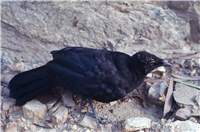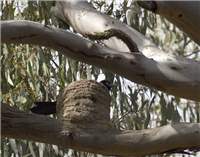Family
Corcoracidae
Genus
Corcorax
Species
melanorhamphos
Threats/Control Methods - Regional
Cats (Felis catus) and Foxes (Vulpes vulpes) will hunt this species. The tidying up of urban space has meant that suitable habitats, with lots of leaf litter and undergrowth are more and more difficult for these birds to find.
Local/Urban Actions
Cat owners can prevent their pets preying on young Choughs by creating a stimulating indoor environment and by installing a cat run or enclosure. Gardens with more natural and less tidied vegetation areas will be more likely to attract birds to shelter and forage.
Common Names
White-winged Chough, Black Jay
Distinguishing Features
The White-winged Chough is a large bird of about 45 cm. It is completely black with white underfeathers, a distinctive red eye and a slightly hooked beak. The young do not reach sexual maturity for four years, and over this time their plumage darkens and their eyes change from brown to orange to red.
Survey Techniques
Call and visual identification.
Species Call
Harsh descending whistles in a downward slide of 't-i-e-e-e-ew, t-i-e-e-e-uw, t-i-e-e-uw'.
Similar Species
The White-winged Chough could be confused with an Australian Raven (Corvus coronoides ), Crow or Pied Currawong (Strepera graculina ), however the Chough's red eye and curved beak is unique.
Distribution
The White-winged Chough is found across the southeast corner of mainland Australia, as far north as southeast QLD.
Country of Origin
Australia
Conservation (Pet/Pest) Status - Regional
The population has fluctuated with a recent rise (COG).
Conservation (Pet/Pest) Status - National
Secure, not listed under the EPBC Act 1999.
LSCCES Population
White-winged Choughs were identified at the ANU, CSIRO, BMt and Turner.
Associated vegetation community
The species prefers a woodland habitat, with a thick ground layer of fallen leaves and bark to forage through. Moisture is also necessary for building their mud-nests.
Limiting Resources
White-Winged Choughs require woodland areas where the ground litter of leaves and twigs has not been neatened or cleared away.
Breeding
The Choughs build large mud nests in tree branches. Their eggs are a cream colour with large brown spots. A clutch size is usually 3-5, however they can have as many as ten. Incubation takes 19 days and young birds stay in the nest for 28 days. Winter is the only season in Canberra with no breeding activity, as the juvenile birds are dependant upon the social group for an extended period of time.
Behaviour
This is a very social species, commonly sighted in groups of around 8 birds, sharing most activities. They seem happy to nest at sights with high human traffic, however they will defend their nest territory during the breeding season with 'wing-waving' displays to deter unwanted intruders. They spend the majority of their time foraging on the ground, head swaying, tail jerking and scratching through leaf litter.
Functional Group
Food Species
The White-winged Chough is mostly a ground forager, racking through ground litter for insects and their larvae, earthworms (Lumbricus terrestris), snails (Helix aspersa) and some seeds. Groups have large feeding territories of up to 1000 ha in area.
Predators
Young birds cannot easily fly when they leave the nest and are an easy target for feral or domestic Cats (Felis catus).
Interesting Fact
Choughs are known to kidnap young birds from neighbouring groups. In times of drought, when moisture for mud-nest building is unavailable, Choughs will use cattle or emu (Dromaius novaehollandiae) dung as a replacement.
References - (reader suitability of references, P=Primary teachers, S=Secondary students, T=Tertiary students and researchers)
Books:Pizzey, G. 2000. The Graham Pizzey & Frank Knight Field Guide to the Birds of Australia. Angus & Robertson, Sydney. P, S, T
Morcomber, M. 2000. Field guide to Australian Birds. Steve Parish Publishing, Archerfield. P, S, T
Veerman, P. 2003. Canberra Birds: A report on the first 21 years of the garden bird survey. Philip Veerman and Canberra Ornithologists Group. Canberra. S, T
Internet: Birds in Backyards. 2006. [online]. Available at:http://www.birdsinbackyards.net P, S, T
Canberra Ornithological Group (COG). 2004. Birds of Canberra Gardens. COG and the ACT Department of Urban Services. [online]. Available at:http://garden.canberrabirds.org.au/ P, S, T
Online Publications:Nix, H. and Cunningham, R. 2006. Birds of the Lower Sullivans Creek Catchment, Canberra ACT. Prepared for the Life in the Suburbs project using data from the Lower Sullivans Creek Catchment Ecological Survey (LSCCES). Australian National University. Canberra. [online]. Available at: http://www.lifeinthesuburbs.com.au/category.php?id=65 S, T


 Top
Top Top
Top